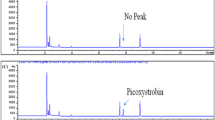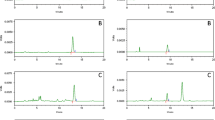Abstract
Amisulbrom formulated as suspension concentrate was applied at the rate recommended for Korean melon to determine the dissipation pattern (at two different sites), the pre-harvest residue limit (PHRL), and risk assessments. Samples collected over 10 days were extracted using liquid-liquid extraction (LLE) and cleaned up with solid-phase extraction (SPE) Florisil cartridge. Residual concentrations were determined using liquid chromatography-ultraviolet detector (LC-UVD) and confirmed by liquid chromatography-tandem mass spectrometry (LC-MS/MS). The standard showed good instrument response linearity with a correlation coefficient (R 2) = 0.9999, and the recovery ranged from 87.5 to 93.7%. The dissipation half-life calculated from two different sites were found to be 7.0 and 8.8 days for sites 1 and 2, respectively. A PHRL graph constructed from the data indicated that if the residue levels were less than 0.55–0.59 mg/kg 3 days before harvest or less than 0.61–0.74 mg/kg 7 days before harvest, then they would be lower than the maximum residue limits (MRLs) at harvest. Risk assessments showed that the risk quotient (RQ) was 4.39–3.47% at 0 day, declined to 1.53–1.63% at 10 days. Therefore, the current data indicate that the amisulbrom can be applied safely to Korean melon; hence, it is unlikely to induce adverse health effects in consumers.




Similar content being viewed by others
References
Ahn, K. G., Kim, G. H., Kim, G. P., Kim, M. J., Hwang, Y. S., Hong, S. B., Lee, Y. D., & Choung, Y. G. (2014). Determination of amisulbrom residues in agricultural commodities using HPLC-UVD/MS. Korean Journal of Pesticide Science, 18(4), 321–329 (In Korean).
Burger, Y., Sa’ar, U., Distelfeld, A., & Katzir, N. (2003). Development of sweet melon (Cucumis melo) genotypes combining high sucrose and organic acid content. Journal of the American Society for Horticultural Science, 128, 537–540.
Chang, H. S., Bae, H. R., Son, Y. B., Song, I. H., Lee, C. H., & Choi, N. G. (2011). Developing a web-based system for computing pre-harvest residue limits (PHRLs). Agribusiness and Information Management, 3(1), 11–22.
Chun, O. K., & Kang, H. G. (2003). Estimation of risks of pesticide exposure by food intake, to Koreans. Food and Chemical Toxicology, 41, 1063–1076.
Chung, H. S., Kabir, M. H., Abd El-Aty, A. M., Lee, H. S., Rahman, M. M., Chang, B. J., Shin, H. C., & Shim, J. H. (2017). Dissipation kinetics and pre-harvest residue limit of pyriofenone in oriental melon (Cucumis melo Var. makuwa) grown under regulated climatic conditions. Biomedical Chromatography. doi:10.1002/bmc.3965.
Codex Alimentarius (2016) Available at http://www.fao.org/fao-who-codexalimentarius/standards/pestres/pesticide-detail/en/?p_id=223
EouroBlight Workshop (2007). Nissan Chemical Industries, Ltd. Amisulbrom (NC-224) Performance of new fungicide for potato late blight control. Available at. http://130.226.173.223/euroblight/Workshop/2007Bologna/PPT/3_Honda_Amisulbrom.pdf
EU-pesticide database. (2016) http://ec.europa.eu/food/plant/pesticides/eu-pesticides-database/public/?event=pesticide.residue.CurrentMRL&language=EN#
Farha, W., Rahman, M. M., Abd El-Aty, A. M., Kim, S. W., Jung, D. I., Im, S. J., Choi, J. H., Kabir, M. H., Lee, K. B., Shin, H. C., & Shim, J. H. (2016). Analysis of mandipropamid residual levels through systematic method optimization against the matrix complexity of sesame leaves using HPLC/UVD. Biomedical Chromatography, 30(7), 990–995.
Fernández-Trujillo, J. P., Picó, B., Garcia-Mas, J., Álvarez, J. M., & Monforte, A. J. (2011). Breeding for fruit quality in melon. In: Breeding for fruit quality (261–278). Hoboken: Wiley.
Francotte, E., Davatz, A., & Richert, P. (1996). Development and validation of chiral high-performance liquid chromatographic methods for the quantitation of valsartan and of the tosylate of valinebenzyl ester. Journal of Chromatography B, 686, 77–83.
Hem, L., Choi, J. H., Park, J. H., Mamun, M. I. R., Cho, S. K., Abd El-Aty, A. M., & Shim, J. H. (2011). Residual pattern of fenhexamid on pepper fruits grown under greenhouse conditions using HPLC and confirmation via tandem mass spectrometry. Food Chemistry, 126, 1533–1538.
Hwang, K. W., Kim, T., Yoo, J. H., Park, B. S., & Moon, J. K. (2012). Dissipation pattern of amisulbrom in cucumber under greenhouse condition for establishing pre-harvest residue limit. Korean Journal of Pesticide Science, 16(4), 288–293 (In Korean).
Kabir, M. H., Abd El-Aty, A. M., Im, S. J., Rahman, M. M., Kim, S. W., Farha, W., Choi, J. H., Jung, D. I., Lee, Y. J., Lieu, T., Shin, H. C., Im, G. J., Hong, S. H., & Shim, J. H. (2016a). Determination of residual levels of metrafenone in lettuce grown under greenhouse conditions using gas chromatography with a micro-electron capture detector. Applied Biological Chemistry, 59(1), 43–49.
Kabir, M. H., Abd El-Aty, A. M., Kim, S. W., Lee, H. S., Rahman, M. M., Lee, Y. J., Chung, H. S., Lieu, T., Choi, J. H., Shin, H. C., Im, G. J., Hong, S. H., & Shim, J. H. (2016b). Residual determination and risk assessment of buprofezin in plum (Prunus domestica) grown in open-field conditions following the application of three different formulations. Biomedical Chromatography, 30, 1721–1727.
Korea Crop Protection Association (2015). www.koreacpa.org, Page no. 146–147 (In Korean).
Lee, E. Y., Noh, H. H., Park, Y. S., Kang, K. W., Kim, J. K., Jin, Y. K., & Kyung, K. S. (2009). Residual characteristics of etofenprox and methoxyfenozide in Chinese cabbage. The Korean Journal of Pesticide Science, 13(1), 13–20 (In Korean).
MFDS (2015a) Available at http://www.foodnara.go.kr/residue/search/list.do?currentPageNo=1&searchType=&searchValue=amisulbrom&searchFlag=PRD
MFDS (2015b), Pesticide safety information. Available at http://www.naas.go.kr/pesticide/adi.do
Montemurro, N., Grieco, F., Lacertosa, G., & Visconti, A. (2002). Chloropyrifos decline curve and residue levels from different commercial formulations applied to oranges. Journal of Agriculture and Food Chemistry, 50(21), 5975–5980.
Nunez-Palenius, H. G., Gomez-Lim, M., Ochoa-Alejo, N., Grumet, R., Lester, G., & Cantliffe, D. J. (2008). Melon fruits: genetic diversity, physiology, and biotechnology features. Critical Reviews in Biotechnology, 28, 13–55. doi:10.1080/07388550801891111.
Ortelli, D., Edder, P., & Corvi, C. (2004). Multiresidue analysis of 74 pesticides in fruits and vegetables by liquid chromatography-electrospray-tandem mass spectrometry. Analytica Chimica Acta, 520, 33–45.
Papadopoulos, E., Kotopoulou, A., Papadopoulos, G., & Hatziphanis, C. (1995). Dissipation of cyproconazole and quinalphos on/in grapes. Pesticide Science, 45, 111–116.
Rahman, M. M., Sharma, H. M., Park, J. H., Abd El-Aty, A. M., Choi, J. H., Nahar, N., & Shim, J. H. (2013). Determination of alachlor residues in pepper and pepper leaf using gas chromatography and confirmed via mass spectrometry with matrix protection. Biomedical Chromatography, 27, 924–930.
SANTE guideline (2015). Guidance document on analytical quality control and method validation procedures for pesticides residues analysis in food and feed. Document No. SANTE 11945/2015.
Shin, A. Y., Kim, Y. M., Koo, N., Lee, S. M., Nahm, S., & Kwon, S. Y. (2017). Transcriptome analysis of the oriental melon (Cucumis melo L. Var. makuwa) during fruit development. PeerJ, 5, e2834. doi:10.7717/peerj.2834.
SPSS. (2010). Data Solution, version 18. Seoul: SPSS.
Sur, N., Pal, S., Banerjee, H., Adityachaudhury, N., & Bhattacharyya, A. (2000). Photodegradation of fenerimol. Pest manage Science, 56, 289–292.
Tasho, R. P., & Cho, J. Y. (2016). Veterinary antibiotic in animal waste: its distribution in soil and uptake by plants: a review. Science of the Total Environment, 563-564, 366–377.
Zhang, J., Chang, V., Giannis, A., & Wang, J. (2013). Removal of cytostatic drugs from aquatic environment: a review. Science of the Total Environment, 445-446, 281–298.
Acknowledgements
This study was supported by a grant (00-16-8-0021-00) from the Ministry of Food and Drug Safety, Republic of Korea in 2016.
Author information
Authors and Affiliations
Corresponding authors
Rights and permissions
About this article
Cite this article
Kabir, M.H., Abd El-Aty, A.M., Rahman, M.M. et al. Dissipation pattern and risk quotients assessment of amisulbrom in Korean melon cultivated in plastic house conditions. Environ Monit Assess 189, 302 (2017). https://doi.org/10.1007/s10661-017-6017-0
Received:
Accepted:
Published:
DOI: https://doi.org/10.1007/s10661-017-6017-0




